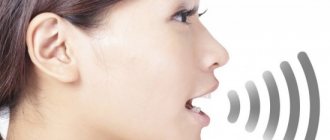The structure of the human speech apparatus
The structure of the speech apparatus in the diagram looks like this:
The speech apparatus is a group of organs of the human body that ensures the organization of the speech process. It includes two interconnected departments: central and peripheral, the so-called executive.
The first is represented by the brain and other formations of the central nervous system, which perform a regulatory function.
In the formation of oral speech, the main role is played by the frontal gyrus of Broca's center, forming the motor area. Foreign speech is perceived by the speech-auditory area formed by the temporal gyri of Wernicke's center. The parietal lobe of the brain is responsible for understanding.
Word acquisition during writing and reading occurs in the visual area in the occipital lobe. Thus, in childhood, when a child observes the articulation of adults, the development of this area affects his speech.
The executive department consists of bones, muscles, nerves and, in turn, has three divisions through which the speech process is carried out.
Let's talk about each of them.
Respiratory section of the speech apparatus
The breathing process is regulated by the central nervous system and consists of successive cycles of inhalation, exhalation, and pauses between them. In this case, the diaphragm works, with the contraction and relaxation of which the lungs change their volume, allowing inhalation and exhalation.
In this process, an air stream is formed, which, when exhaled, is involved in the appearance of voice and speech sounds. The clarity of pronunciation depends on its strength and direction.
Talking teeth
Anastasia Lyubalina
Administrator of the dental clinic "Ekostom"
Even in early childhood, we master all speech patterns, including speech motor standards for each specific sound. Impulses from the brain enter the speech organs, as a result we can pronounce sounds, and therefore speak. This skill is brought to automaticity in most healthy people in childhood and is not lost throughout life.
With age, in the course of life, people may experience various changes in the structure of the dental system, for example, tooth loss. The reasons for this may be: a change from a primary dentition to a permanent one (if the timing of this process is extended), genetic diseases, decreased immune processes, diabetes mellitus, trauma, insufficient oral hygiene at home or untimely visit to the dental clinic, as well as non-compliance with measures prevention and dentist recommendations and much more. Of course, these changes will entail characteristic secondary disturbances in the aesthetics of the face, the digestive process, and, of course, speech activity, in particular sound pronunciation.
Despite the high compensatory capabilities (as we know, the dental system is capable of self-regulation in terms of adaptation to changing external conditions), the older a person is, the more already honed skills suffer. Let us consider in more detail the mechanism of violations.
When teeth are lost, the organs of the dental system (mostly the tongue) tend to “fill” the resulting empty space. In this case, the tongue takes an inadequate position for itself both at rest and in the process of sound formation. The lips and cheeks seem to “sink” in the place where teeth are missing. In this regard, all speech-motor structures are disrupted, therefore, sound pronunciation is disrupted according to the type of distortion.
Depending on which segment is missing a tooth or several teeth at once, the pronunciation of different groups of sounds is correspondingly impaired. The violations are most clearly manifested in complete edentia, when all teeth are missing in the oral cavity. In this case, the pronunciation of all speech sounds is impaired.
Let's look at examples.
Depending on the location of the lost teeth, the pronunciation of the following groups of sounds is impaired:
1. labiodental sounds [V], [F] and their soft variants, if there are no lower incisors. The lower lip and upper incisors are involved in the process of pronouncing these sounds. The teeth seem to rest on the lower lip, and the air stream passes through an obstacle in the form of a “fence” of the teeth. In the absence of upper incisors, the air stream does not overcome the barrier created by the organs of articulation, which means the pronunciation is distorted.
2. Dental sounds [D], [T], [N], [L], their soft variants and the sound [C]. In the process of pronouncing these sounds, the tongue seems to be pushed away from the back wall of the upper incisors. In the absence of front teeth in the upper jaw, the tongue “falls” into an empty space in the dentition, preventing the organs of articulation from making the necessary movements. The pronunciation of sound becomes impaired.
3. Palatodental sounds [Ш], [Ш], [ж] In the process of pronouncing these sounds, the lateral edges of the tongue rest against the back wall of the chewing teeth, and in their absence, it occupies empty space, changing the speech motor structure of the pronounced sound, making it difficult to pronounce .
Specific to people with incomplete teeth is the so-called “lisp.” This change in pronunciation is associated with the incorrect position of the organs of articulation in the oral cavity, with a violation of the algorithm of movement of these organs. Depending on the specific reasons, a person may have a lisp in different ways. In some cases, a speech defect may be barely noticeable, and sometimes lead to a pronounced disruption of communication between people. This issue is especially acute for people in “speech professions” (speakers, teachers, etc.). It is typical for patients to switch to whispered speech, because this masks the lack of pronunciation.
The most modern and effective way to get rid of the disease is to restore the dentition through implantation and prosthetics. When installing orthopedic structures, the anatomical and physiological integrity of the dentofacial apparatus is returned to the patient. As a result, the speech organs return to their normal and familiar state at rest, and also take the correct position in the process of speech formation.
The sooner a patient addresses this problem to specialists of the appropriate profile, the more likely it is that the sound-pronunciation side of speech will be fully restored in a short time.
Expert opinion
Vitaly Zotkin
Doctor - orthopedic dentist at the Ecostom clinic
Changes in the speech of patients associated with tooth loss are always obvious and immediately reveal the problem. An experienced specialist can determine the location of a lost tooth by ear, down to the segment and serial number, already at the stage of the initial consultation.
For many patients, especially those whose profession is related to speech communication, in addition to other advantages of prosthetics and implantation, the effective rate of restoration of correct speech is very important. Oddly enough, this point is one of the most important in orthopedic dentistry. It is necessary to understand that in order to achieve the desired result, you need to select the working methods and, of course, the materials of the future design as accurately as possible. Using high-precision equipment and computer technology, orthopedic dentists, together with dental technicians, restore the complete anatomy of lost teeth, taking into account all the individual characteristics of the dental system of each individual patient.
During the treatment process, the specialist is obliged to warn the patient that after installation of the structure, speech function will not be restored immediately. This is due to the fact that the organs of the oral cavity responsible for speech formation “existed” for some time in the absence of teeth and managed to get used to them. There must be an adaptation period. Getting used to the prosthesis can take a long time, and the product may need to be adjusted. To shorten the adaptation period, training exercises are used, for example, reading poetry out loud, pronouncing tongue twisters, and articulation gymnastics.
As a rule, in all cases, after installation of the orthopedic structure, pronunciation is completely normalized, which is especially valuable for patients.
State of the speech apparatus
When all the components of this complex mechanism are functioning properly, the process of speech formation looks like this:
- the brain gives a command to organize speech movements;
- an air stream is formed in the respiratory section, which is directed to the larynx;
- in the vocal tract, the vibration of the vocal folds creates the voice;
- in the articulatory department, sounds are formed, which, thanks to resonators, receive strength and color, and our speech is made up of sounds.
This is when the speech apparatus is working properly. When failures occur, what then? Then various kinds of speech problems arise.
The main causes of disturbances in the functioning of the speech apparatus may be:
- defects in the structure of the speech organs;
- its incorrect operation;
- pathologies of the central nervous system.
Since speech is an important form of communication, speech disorders have a negative impact on all areas of the life of a modern person.
Speech problems need to be taken seriously. Take action in a timely manner and make every effort to eliminate speech deficiencies - this is how you can regain the freedom and joy of communication.
How to maintain the working condition of your speech apparatus? Here are some tips:
- Correct posture improves its functioning - keep your head straight and your back straight.
- If your vocal organs are overloaded, practice relaxing them to restore functionality. To do this, you can perform special exercises, for example, take a resting pose, or just be silent for a while.
- Avoid hypothermia, irritation of the mucous membrane, prevent colds.
- If you want to improve the quality of your speech, train your diction, learn to breathe correctly, and take care of its content.
Stages of speech formation
The respiratory section of the vocal apparatus is responsible for supplying air, the vocal apparatus forms the voice, and the function of the articulatory apparatus is to create the resonance necessary for distinct sound and volume. Pronouncing a word consists of several stages. First, commands are selected in the cerebral cortex, that is, a specific articulatory program is formed. Subsequent stages:
- Implementation of the prepared program in the executive department of the vocal apparatus. The respiratory organs and resonator system take part. They help pronounce certain phonemes.
- To avoid errors during pronunciation, kinesthetic control is necessary, which allows you to make corrections before the phoneme is pronounced.
- At the moment the sound is heard, auditory control is carried out, allowing a person to understand the mistake made and correct it.
The pathways form the conduction section. Nerve pathways are divided into two types: centrifugal (transmit information from the central nervous system to the muscles, ligaments and tendons) and centripetal (information moves in the opposite direction - from the muscles, tendons and ligaments to the central nervous system). In the second case, the paths are also called sensitive.
Implementation of speech function
Two centers are responsible for the sound of speech: sensory and motor speech. The first helps to perceive phonemes and distinguish them from each other, while the second is necessary for reproducing sounds, words and sentences. In psychology, it is customary to distinguish two types of speech:
- impressive, that is, understanding someone else’s oral and written speech;
- expressive, pronounced out loud with a certain intonation, rhythm, tempo.
It is interesting that a healthy infant in the first year of his life can reproduce up to 75 shortest sounds, that is, at the physiological level he is capable of learning any language in the world. In the future, everything depends on what language is spoken in his family.
To learn to speak competently, every person must understand what subsystems there are in the Russian language. These include:
- Phonetics. The science of speech sounds - phonemes, the rules of their articulation from the perspective of physiology.
- Semantics. Helps to understand the meaning of each lexical item.
- Syntax. Allows you to understand how sentences are formed from individual words.
- Vocabulary. Studying the vocabulary richness of the language.
Speech sounds in Russian are divided into consonants (they are noises) and vowels (tones). The former are divided into voiceless and voiced, hard and soft, and the latter into stressed and unstressed. These signs are usually called semantically distinctive. There are 42 phonemes in the Russian language, of which 36 are consonants and 6 are vowels.







